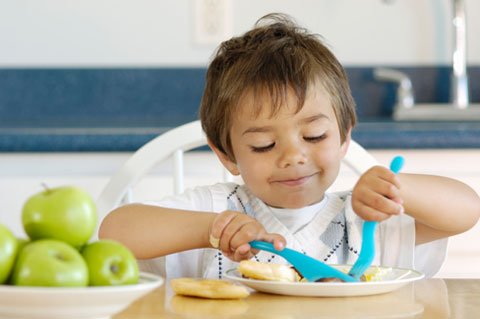
Eating together as a family takes on a new dimension as your family grows. There’s a baby who’s learning to self-feed, a fussy toddler who wants to have dessert for dinner and two parents who are trying to have a decent meal.
Sitting down at the table for a meal together as a family unit is an excellent way to foster a healthy relationship with food for your children.
They learn how to behave by watching the parents.
The ideal situation is when everyone is seated and the children are behaving themselves by eating and finishing their food.
In reality, the baby is throwing food out of his bowl, the toddler is whining for food other than what is served on the table, the father is trying to coax the toddler to eat and the mother is stopping the baby from throwing more food. Sounds familiar?


So, how can we make this time a little more enjoyable despite the imminent chaos?
Establish table manners
Whatever family rules you have set for table manners, make sure everyone in the family knows about them.
For example, if dinner starts at 6pm, everyone should be seated around the table at 6pm.
If you want your children to stay at the table until everyone has finished, make sure everyone understands this. Some parents prefer to let their children leave the table once they are done so that they can eat the rest of their meal in peace.

There’s no one rule that fits all.
Establish those that fit your family’s lifestyle; there’s no right or wrong. Whatever rules that you have decided for your family, follow through and be consistent.
Plan meals and prep ingredients in advance
When you’re taking a long time to prepare ingredients and do the actual cooking, you could become too tired after everything is done.
When you’re tired, it’s hard to be in the mood to enjoy eating with your family.
In fact, a complicated five-course meal isn’t necessarily appealing to your children, so best bet is to keep it simple and as fuss-free as possible.
So, rather than attempting to prepare three different meals (this takes up a lot of time!) or to make one meal the children will eat, you can try cooking three meals from one basic set of ingredients: a simple baby-friendly dinner, an eye-catching meal for even the fussiest of toddlers and a delicious dinner for the grown-ups.
Quick tips:
- Marinate meats the day before and keep in the fridge.
- Cut root vegetables into bite-sized pieces and keep in Ziploc bags in the fridge.
- Cook chicken or meat broth during weekends and store them in mason jars in the fridge.
- Replace water with broth to get tastier dishes.
NO gadgets at the dining table

As hard as it may be to put aside your gadgets, try to do so for the duration of meal time.
If not urgent emails or WhatsApp messages come in, make it a habit to leave it until after everyone is done.
By turning off distraction from your mobile phone, iPad or even the TV, you can focus on having a relaxed dining atmosphere, thus enhancing enjoyment and consequently encourages good eating habits in the children.
Encourage conversation
Make mealtime fun with an engaging conversation where the whole family could unwind and relax.
You could ask your children questions like “Who did you play with at school?” or “What’s your favourite game during playtime?”
Try to make mealtime a time whereby your children are looking forward to it and you’re actually enjoy sitting down and eating together instead of dreading it.
Drop the nagging and bribing
While you’re doing a good job at having a great conversational mealtime, don’t kill the mood with constant nagging and bribing.
Try not to get frustrated and angry if your children don’t clean their plate or they don’t eat their veggies.

Try not to bribe your children with dessert just because you want them to eat one more spoon.
Remember, the key to fostering healthy eating is enjoyable and pleasant family meal times.
Keep up the good work if you’re already working on it; good luck if you’re about to work on it!
In collaboration with Ethissa.








